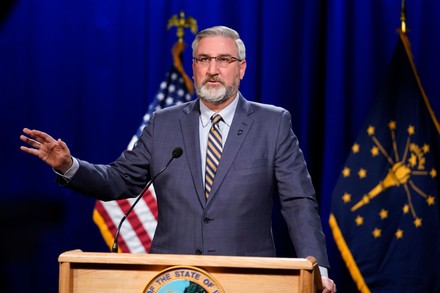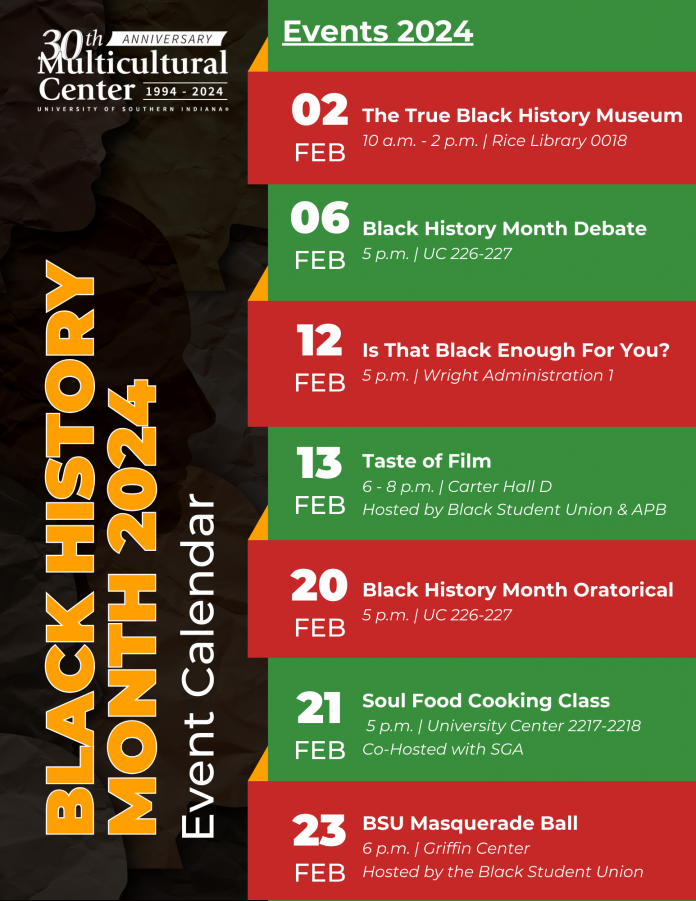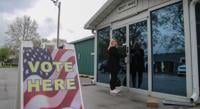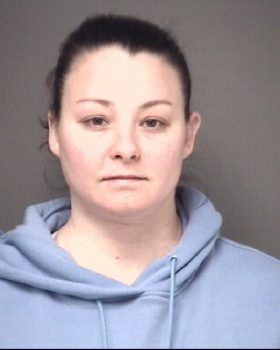| Mike Goebel is a lifelong resident of Southern Indiana and a graduate of Mater Dei High School. While holding a full-time night shift job, he earned a Bachelor of Science in Social Studies from USI (ISUE) in 1974. He received his Master’s Degree in History from Indiana State University in 1978.
Mike’s daughter, Mackenzie, graduated with honors from IU’s Kelley School of Business and currently resides in Nashville, Tennessee with her husband Chris, son Zeke, and new daughter Lucy. My son, Zachary “Bo”, graduated as a 1st Team All-American football player from Georgetown in 2012. He then joined the US Army, graduating from OCS and Ranger School. Captain Goebel was deployed to Iraq in 2016-17. Upon his return, Captain Bo served in the Old Guard, Escort to the President in Washington, DC. Bo is currently stationed at Ft Benning, GA where he resides in Columbus with his wife Tara, son Camden, and new daughter Georgia. Mike’s wife, Melanie, is an outstanding veteran teacher at Holy Rosary School; both she and he were nominated as candidates for the 2016 “Outstanding Educator of the Year Award” sponsored by the Evansville Courier and Press and the University of Evansville). Melanie’s children live in Indianapolis, Houston, and Salt Lake City. County Councilman Goebel thoroughly enjoyed teaching government and history at Mater Dei High School. He served as Social Studies Department Chairman for 17 years. Goebel has also been fortunate to coach IHSAA state championship teams in the sports of football and wrestling. Mike stated that “serving as your past Vanderburgh County Councilman for the last 12 years has been a challenging and fulfilling experience”. I am extremely proud of my conservative voting record while serving on the Vanderburgh County Council. I will be honored and humbled to serve you on the Vanderburgh County Commission. |
VANDERBURGH COUNTY COUNCILMEN MIKE GOEBELTO RUN FOR COUNTY COMMISSIONER
blacks
Popular understanding of Indiana black history focuses on post-Civil War African-American migration to cities in the north, such as Evansville, Fort Wayne, Gary, Indianapolis and South Bend. This generalized thinking situates Indiana’s African-Americans as part of a national story, but fails to reveal the stories of free blacks and formerly enslaved people who settled the state much earlier. These untold stories have the potential to evoke pride and add a level of complexity to our understanding of black heritage and Hoosier history. With a mounting interest in history related to Indiana’s Bicentennial, now is an opportune time to uncover and share untold parts of Indiana’s history.
Despite a rich history, little is known about the African-American experience from the state’s founding to the Civil War era. With the exception of a handful of monographs, graduate papers and journal articles, few publications have been written that focus on this history. Over the past 30 years, various research projects related to early black settlements have been completed by independent researchers, college professors and students, IHS, Indiana Humanities, Ball State University, Conner Prairie and Indiana Landmarks.
A planning grant from Lilly Endowment Inc. allowed IHS to convene interested organizations to guide a team of researchers to gather available research on early black settlements. These organizations include Southern Indiana Minority Enterprise Initiative, Indiana Landmarks, Indiana Historical Bureau, Indiana Tourism, Indiana Humanities, Indiana State Library, Indiana State Archives and the Indiana State Museum and Historic Sites.
African American Settlements IN Vanderburgh County And Surrounding Areas
Vanderburgh County was founded in 1818.  From the first federal decennial census for the county in 1820 to 1870, the recorded African American population increased from 3 to 2,151 people.  By 1840, there were over 100 black residents in the county, but like so many other Indiana counties, the black population census numbers fell between 1850 (227) and 1860 (127) and zoomed upward in 1870 (2151).  These numbers very much reflected the political mood of the state during the 1850s, and the outcome of the Civil War and the state’s close proximity to Kentucky in 1870.  Although there were comparatively large population numbers of African Americans in several townships, the majority (1427) were drawn to the city of Evansville in Centre Township after the war.
Daniel Lyles owned land near present day Burdette Park in Union Township. Â The land was surveyed in 1856. Â He had large property holdings. An African Methodist Episcopal church was established in 1850. Â Trustees included William Bug, Ezekiel Gillespie and Henry Jackson. Â The church no longer exists. Alfred Lilies also owned land. Â This unnamed settlement appears to be connected to Lyles Station and other black rural communities in Gibson County. Â Families in these settlements used variant spellings of the Lyles/Liles surname.
By 1870, there were also large masses of African Americans settled in Knight, Perry, Pigeon, and Scott Townships in Vanderburgh County.
Popular understanding of Indiana black history focuses on post-Civil War African-American migration to cities in the north, such as Evansville, Fort Wayne, Gary, Indianapolis and South Bend. This generalized thinking situates Indiana’s African-Americans as part of a national story, but fails to reveal the stories of free blacks and formerly enslaved people who settled the state much earlier. These untold stories have the potential to evoke pride and add a level of complexity to our understanding of black heritage and Hoosier history. With a mounting interest in history related to Indiana’s Bicentennial, now is an opportune time to uncover and share untold parts of Indiana’s history.
Despite a rich history, little is known about the African-American experience from the state’s founding to the Civil War era. With the exception of a handful of monographs, graduate papers and journal articles, few publications have been written that focus on this history. Over the past 30 years, various research projects related to early black settlements have been completed by independent researchers, college professors and students, IHS, Indiana Humanities, Ball State University, Conner Prairie and Indiana Landmarks.
A planning grant from Lilly Endowment Inc. allowed IHS to convene interested organizations to guide a team of researchers to gather available research on early black settlements. These organizations include Southern Indiana Minority Enterprise Initiative, Indiana Landmarks, Indiana Historical Bureau, Indiana Tourism, Indiana Humanities, Indiana State Library, Indiana State Archives and the Indiana State Museum and Historic Sites
Popular understanding of Indiana black history focuses on post-Civil War African-American migration to cities in the north, such as Evansville, Fort Wayne, Gary, Indianapolis and South Bend. This generalized thinking situates Indiana’s African-Americans as part of a national story, but fails to reveal the stories of free blacks and formerly enslaved people who settled the state much earlier. These untold stories have the potential to evoke pride and add a level of complexity to our understanding of black heritage and Hoosier history. With a mounting interest in history related to Indiana’s Bicentennial, now is an opportune time to uncover and share untold parts of Indiana’s history.
Despite a rich history, little is known about the African-American experience from the state’s founding to the Civil War era. With the exception of a handful of monographs, graduate papers and journal articles, few publications have been written that focus on this history. Over the past 30 years, various research projects related to early black settlements have been completed by independent researchers, college professors and students, IHS, Indiana Humanities, Ball State University, Conner Prairie and Indiana Landmarks.
A planning grant from Lilly Endowment Inc. allowed IHS to convene interested organizations to guide a team of researchers to gather available research on early black settlements. These organizations include Southern Indiana Minority Enterprise Initiative, Indiana Landmarks, Indiana Historical Bureau, Indiana Tourism, Indiana Humanities, Indiana State Library, Indiana State Archives and the Indiana State Museum and Historic Sites.
African American rural settlements documented: 1
Vanderburgh County was founded in 1818.  From the first federal decennial census for the county in 1820 to 1870, the recorded African American population increased from 3 to 2,151 people.  By 1840, there were over 100 black residents in the county, but like so many other Indiana counties, the black population census numbers fell between 1850 (227) and 1860 (127) and zoomed upward in 1870 (2151).  These numbers very much reflected the political mood of the state during the 1850s, and the outcome of the Civil War and the state’s close proximity to Kentucky in 1870.  Although there were comparatively large population numbers of African Americans in several townships, the majority (1427) were drawn to the city of Evansville in Centre Township after the war.
Daniel Lyles owned land near present day Burdette Park in Union Township. Â The land was surveyed in 1856. Â He had large property holdings. An African Methodist Episcopal church was established in 1850. Â Trustees included William Bug, Ezekiel Gillespie and Henry Jackson. Â The church no longer exists. Alfred Lilies also owned land. Â This unnamed settlement appears to be connected to Lyles Station and other black rural communities in Gibson County. Â Families in these settlements used variant spellings of the Lyles/Liles surname.
By 1870, there were also large masses of African Americans settled in Knight, Perry, Pigeon, and Scott Townships in Vanderburgh County.
BIBLIOGRAPHY
Atlas of Vanderburgh Co.; Plat Book of Vanderburgh and Warrick Counties, Indiana. Evansville: n.p., 1975.
Bigham, Darrel E. We Ask Only a Fair Trail: A History of the Black Community of Evansville, Indiana; Indiana University Press, 1987.
U.S. Bureau of the Census. “Aggregate Amount of Each Description of Persons within District of Indiana,†1: 352. Sixth Census of the United States, 1840. Washington, D.C.: U.S. Census Office, 1841.
U.S. Bureau of the Census. Population of Civil Divisions Less Than Counties; Table III State of Indiana,†1:124 Seventh Census of the United States, 1850 Washington, D.C.: U.S. Census Office, 1852.
U.S. Bureau of the Census. Population of Civil Divisions Less Than Counties; Table III State    of Indiana,†1:124 Eighth Census of the United States, 1860.  Washington, D.C.: U.S. Census Office, 1862.
U.S. Bureau of the Census. “Population of Civil Divisions Less Than Counties; Table III—State of Indiana,†1: 124. Ninth Census of the United States, 1870. Washington, D.C.: U.S. Government Printing Office, 1872.
Audrey C. Werle “Research Notes on Indiana African American History,†M 792.  William Henry Smith Memorial Library, Indiana Historical Society, Indianapolis, Indiana.
Get Crafty this February with WPL’s Adult Crafternoon!
|
USI to host February events to honor Black History Month
The University of Southern Indiana is hosting a variety of events and activities in February to honor Black History Month. The month will include a debate, Black History film showing and more.
Events include:
True Black History Museum
10 a.m. to 2 p.m. Friday, February 2, Rice Library 0018Â
The True Black History Museum is a traveling museum that teaches true Black history using rare and authentic artifacts. It is committed to preserving the history of African Americans, teaching individuals about the many great contributions that African Americans have made throughout history.
The exhibit, entitled, “A Tribute to the African American Journey,” takes visitors on a journey through the African American experience. Artifacts in the collection range from the many great African civilizations, the slave trade, slavery, the Civil War, Reconstruction, Jim Crow, the Civil Rights/Black Power movement and the modern day. The collection celebrates and highlights the contributions of African Americans in the arts, sciences, sports, entertainment, education and politics.
Black History Month Debate
5 p.m. Tuesday, February 6, University Center East 226-227Â
The USI Multicultural Center will host its 6th annual Debate. This event will allow for open discussion on topics related to Black History. It is open to the USI community, and refreshments will be served.
Black History Film Showing – Is That Black Enough For You?!?
5 p.m. Monday, February 12, Wright Administration 1Â
This documentary examines African American contributions to film and pop culture. It provides insight into the history of Black representation from the earliest days of cinema and the cultural impact of witnessing unapologetic Blackness. The film features commentary from Harry Belafonte, Samuel L. Jackson, Laurence Fishburne, Whoopi Goldberg, Margaret Avery, Zendaya and more. This event is open to the public at no charge.
Runtime: Two hours and 15 minutes (Rated R for nudity, some sexual content, language, violence and drug material)
Taste of Film:Â The Princess and the Frog
6-8 p.m. Tuesday, February 13, Carter Hall D (located in University Center West)Â
The USI Black Student Union and Activities Programming Board are partnering to host a Taste of Film event, featuring a showing of The Princess and the Frog. Beignets and gumbo will be served to the campus community. This event is open to the public at no charge.
Oratorical Competition
5 p.m. Tuesday, February 20, University Center East 226-227Â
The USI Multicultural Center will host the 6th annual Oratorical Competition. USI participants are asked to prepare speeches between three minutes and 30 seconds and five minutes and 30 seconds in length. This event is open to the public at no charge.
Soul Food Cooking Class
5 p.m. Wednesday, February 21, UC 2217-2218 (located in University Center East)Â
The USI Multicultural Center and Student Government Association are collaborating to host a Soul Food Cooking Class featuring Chef Gregory with Sodexo, USI’s food service partner. This event is only open to USI students. Registration can be done through EagleSync.
Black Student Union Gala
6 p.m. Friday, February 23, Griffin CenterÂ
The Black Student Union (BSU) will host its annual Gala. This year’s theme is a Masquerade Ball. The Gala is open to the USI campus community.
For ques
The February GOP breakfast is THIS SATURDAY!
|
|
|
|
|
|
|
|
|
|
Vincennes University introduces cutting-edge collaborative robots to Early College career centers
VINCENNES, Ind., January 29, 2024 – The Vincennes University Center for Applied Robotics and Automation (CARA) has taken a significant leap into the future of education and technology by deploying 12 collaborative robots across eight Early College career centers in Indiana.
These cobots mark the beginning of an initiative to bring more Industry 4.0 technologies to high school students in Indiana. The Area 31 Career Center in Indianapolis received three cobots from the CARA in mid-January, and CARA Technical Advisor Morgan Chang trained five instructors and staff. Cobots are being used immediately in the classroom and were featured in a showcase during an open house on Jan. 25.
VU leads the largest cobot educational project in the United States with the support of a Lilly Endowment Inc. grant and in partnership with Telamon Robotics.
By introducing such advanced tools at Early College career centers, the CARA is not only enhancing the learning experience but is preparing students for the evolving demands of the modern workforce.
CARA Director Kimberly Wright said, “Empowering the next generation with Industry 4.0 technologies is not just a choice. It is a necessity. The deployment of 12 cobots at Early College Career Centers throughout the state is a visionary step towards preparing students for a future where innovation and automation go hand in hand. By embracing these technologies, we are bridging the gap between education and industry and cultivating a workforce that thrives in the high-tech era, ensuring a brighter and more competitive Indiana.â€
VU’s innovative initiative marks a milestone in integrating cutting-edge automation into the learning environment, offering students hands-on experience with the latest technology. Cobots work alongside humans and provide a unique opportunity for students to develop essential skills in robotics and automation.
According to a recent survey report by Conexus Indiana and the Indiana University Kelley School of Business, 51 percent of Indiana manufacturers expect to adopt cobots in the next five years.
“The integration of this technology into our curriculum and programs presents a fantastic opportunity for our students to gain hands-on experience with these state-of-the-art cobots,†VU Early College Site Director at Area 31 Maria Srnka said. “Furthermore, utilizing these cobots in outreach activities will undoubtedly play a crucial role in attracting more students to pursue STEM pathways. We extend a huge thank you to everyone involved in making this initiative a reality.â€
VU’s forward-thinking approach reflects the University’s commitment to fostering a dynamic educational environment that aligns with industry trends and equips students with the skills needed for success in a rapidly changing world.
Weak voter participation is ‘significant challenge’ for Indiana, survey says
-
The latest assessment of Indiana’s civic health shows the state is continuing to suffer from persistent voter apathy, with low numbers of Hoosiers registering to vote and casting a ballot.
According to the 2023 Indiana Civic Health Index, released Wednesday, the state has a “significant challenge†of getting eligible voters to participate in the election process. Voter turnout in Indiana has been consistently below the national average for decades, and it regularly ranks in the bottom half of all states for voter registration.
In the 2022 midterm elections, only 41.9% of Hoosier voters went to the polls, which is more than 10 percentage points below the national average of 52.2%. Even when turnout spiked in the 2020 presidential election, when 61.9% of eligible Hoosiers voted—the highest turnout for a presidential election since 1994—Indiana still fell short of the national average of 66.8%.
The Indiana Bar Foundation and the Indiana Civics Coalition curated the report. Along with compiling and examining the new data from the 2022 election cycle, the bar foundation and the coalition based their findings on the National Conference of Citizenship’s analysis of the U.S. Census Current Population Survey data.
Partnering organizations that helped produce the 2023 index are Indiana University Northwest, The Center of Representative Government at Indiana University, the Indiana Civics Coalition, the Indiana Citizen Education Foundation Inc. (parent of The Indiana Citizen), Church Church Hittle and Antrim, and the National Conference on Citizenship.
A voter enters a polling place at Scott Hall located at the Johnson County Fairgrounds in 2022. Johnson County is one of 59 vote center counties, meaning citizens can cast their vote at any polling location in the county. As Charles Dunlap, president and CEO of the Indiana Bar Foundation, explained, all the survey partners are hopeful Indiana can improve its civic health, but progress will not happen quickly.
“This is moving a big ship,†Dunlap said. “This is not going to be an overnight thing. This is a lot of people putting their shoulder to the wheel on this, and that’s how we think effective change can be made.â€
The 2023 civic health index is the sixth edition to be published since the first one, which was championed by former U.S. Rep. Lee Hamilton and retired Indiana Chief Justice Randall Shepard, came out in 2011.
Partners on the civic health index project—former Indiana Attorney General Greg Zoeller; Ellen Szarleta, director of the Center for Urban and Regional Excellence at Indiana University Northwest; and Bill Moreau, co-founder of The Indiana Citizen Education Foundation—joined Dunlap on Jan. 24 to discuss the findings of the latest index and recommend ways to improve.
The release of the 2023 index was covered by Fox 59 News, The Post-Tribune, WFYI, The Indiana Lawyer, and Northwest Indiana Business Magazine. Also, the index was the subject of columns in TheStatehouseFile.com and The Terre Haute Tribune Star and discussed on Indiana Week in Review.
“I’m so optimistic about his report regardless of what it might say to others,†Zoeller said. “It’s not so much a metric on who we are as a citizenry but so much as a challenge that we rise to the occasion.â€
New civics classes bode well for future
Civic health is comprised of more than just voter participation, Szarleta said. Civic awareness, which includes knowledge about democracy and how to engage in the democratic process, and social connectedness to family, friends, neighbors and coworkers are also key indicators of civic health.
Improving Indiana’s civic health, she said, will have a broad impact by bolstering economic resilience, workforce development, and access to opportunities as well as lowering crime rates.
“When we make choices about how to civically participate, it’s not just that we’re going to vote or connecting to one another, but we’re actually affecting our lives on a more general level,†Szarleta said.
While voter participation is a concern, Dunlap pointed out some areas where Indiana’s civic health are “extremely strong.â€
Namely, he highlighted the new state requirement that all sixth graders take a full semester of civics instruction, making Indiana just one of eight states that mandate at least a semester of civics education at the middle school level. Also, the bar foundation is planning to expand its Indiana Kids Election program to bring to elementary, middle and high school students the experience of voting in a mock election.
The civics class was born from the 2019 civic health index. A recommendation for the class led to the creation of a civic education task force, chaired by Lt. Gov. Suzanne Crouch, which produced a report that became the basis for the legislation that established the sixth grade requirement.
Based on research showing a link between civic knowledge and civic health, Szarleta said the class will provide a long-term benefit. The new civics class and other civic-related activities will help Indiana students develop their critical-thinking skills, so they are more engaged in their communities and more likely to participate in elections, she said.
Since the new civics class and mock elections are just now getting started, Szarleta noted the full benefit of this education might not be seen for another 10 years, when the current crop of sixth graders reach voting age. However, she said, “You are going to have more positive outcomes in terms of future civic activities.â€
Registration first, then voting
Moreau said as the emphasis on civics education is celebrated, Hoosiers should also be thinking about what comes next. Students will be gaining an understanding of how democracy works, and they should also be shown the way to use that knowledge.
“What is the most obvious manifestation of that engagement for an 18-year-old?†Moreau asked. “It’s first registering and then voting.â€
The 2023 index calls for increasing voter registration efforts in 2024. Previously, the civic health index had highlighted election administration policy choices made by states with the highest turnout rates, such as automatic voter registration, same-day voter registration, unrestricted absentee voting and keeping the polls open longer than 12 hours on Election Day.
None of those recommendations have been enacted by the Indiana General Assembly, and impediments remain in Indiana’s voting system, Moreau said. But he pointed out that more than 3 million Hoosiers figured out how to navigate the system and vote in 2020.
Consequently, he believes the voter turnout in Indiana can climb if more eligible voters are registered. A prime target for registration efforts, he said, will be the estimated 160,000 high-school juniors and seniors who will be eligible to vote this year.
Moreau pointed to social science studies that found upwards of 80% of first-time registrants and new registrants vote.
“They’ve figured out how to take step one, and they take step two very seriously,†Moreau said about registering and voting. “In fact, I’ve seen some research that indicates that first-time voters are among the best-informed voters when they go into the voting booth.â€
Zoeller agreed about the potential that newly registered voters hold because they will likely show up at the polls and they might consider the candidates more carefully rather than just voting for the party.
When he was campaigning door to door, Zoeller said, he made an extra effort to meet with the voters who had just registered. “They’re up for grabs, and you’ve got to argue your case.â€
Participation strengthens democracy
An influx of voters is need for the health of democracy, Moreau said, but currently, “Hoosiers are staying home.â€
Szarleta said Hoosiers are staying home more in general.
The 2023 index indicated Indiana residents preferred online interactions to in-person connections. In 2022, slightly more Hoosiers posted their views on social political issues on the internet than in 2020. At the same time, Hoosiers spent fewer hours volunteering, socializing with neighbors and attending public meetings.
Szarleta did not draw any conclusions about social connectedness from the stats. She noted that over the 12 years of collecting data for the indexes, Indiana has posted mixed results on civic engagement but longer term trends have not been spotted.
The American home still has an important place in democracy, Zoeller said. Parents can pass along the traditions of civic participation to their children through discussions at the dinner table or by taking them to the polls on Election Day so they can see what voting looks like.
“It’s incumbent upon all of us,†Zoeller said, “to do more regardless of what the metrics or the statistics say because we believe in representative democracy and recognize the value and the importance of engagement in civic health.â€
Editor’s note: This article has been updated to provide a listing of the news outlets that covered the release of the 2023 Indiana Civic Health Index.
This article was published by TheStatehouseFile.com through a partnership with The Indiana Citizen, a nonpartisan, nonprofit platform dedicated to increasing the number of informed, engaged Hoosier citizens.
Indiana Citizen Editor Marilyn Odendahl has spent her journalism career writing for newspapers and magazines in Indiana and Kentucky. She has focused her reporting on business, the law and poverty issues.
Gov. Holcomb’s 2024 Next Level Agenda prioritizes early childhood education workforce

Indiana’s workforce training programs to offer early childhood education and child care credentials
INDIANAPOLIS – Governor Eric J. Holcomb announced today the addition of early childhood education and child care credential training options under Indiana’s signature workforce training programs. As part of his 2024 Next Level Agenda announced earlier this month, the governor pledged to open existing financial aid dollars for early childhood professions that will help grow the state’s child care and preschool workforce pipeline.
“Child care is an important issue that has increasingly become a key workforce issue,†Gov. Holcomb said. “It’s critical that parents have access to quality child care, and quality child care starts with ensuring that the professionals caring for children are well prepared and receiving the necessary tools and appropriate training that prioritizes the safety of some our youngest Hoosiers.â€
The training programs will be funded through the Workforce Ready Grant and Employer Training Grant. Implemented jointly by the Commission for Higher Education and Department of Workforce Development, the Workforce Ready Grant covers the tuition and fees for individuals trained through qualifying certificate programs, which now includes credentials such as the Child Development Associate and other early childhood education programs. The Employer Training Grant reimburses employers who train, hire and retain workers in high-demand positions. The program can be used for both new and preexisting employees.
“We are excited about the outcome this effort will have on our talent pool and the addition of certified and committed staff throughout the state,†said Courtney Penn, Director of the Office of Early Childhood and Out-of-School Learning. “Birth to age five are the most critical years in a person’s life, making it imperative the child care workers we’re putting in our early learning environments are well-rounded and top notch.â€
The state continues its efforts to add high-quality child care programs, and attracting more well-trained child care workers is critical to that effort. Shortages and turnover at child care programs hinder access to quality care Hoosier workers need for their families. Recent state grant opportunities supported businesses and communities in adding nearly 100 new child care solutions including on-site or near-site child care, backup care and tri-share programs for working Hoosiers, and created openings for more than 1,500 children throughout the state.
“The expansion of the Next Level Jobs programs to include youth education and development occupations will have a great impact on our state as early childhood education provides a foundation for future learning and growth,” said Indiana Commissioner for Higher Education Chris Lowery. “Indiana has a critical need for early childhood education and child development professionals. The Workforce Ready Grant will help meet that need and place more Hoosiers in high-demand roles leading to greater social and economic mobility and prosperity.â€
Since 2017, the Workforce Ready Grant has helped over 47,000 Hoosiers complete credential training in high-wage, high-demand careers. Now, the financial aid program will also assist training and upskilling in the high-value, high-demand sector of early childhood education. The employer Training Grant has helped 1,400 employers upskill nearly 17,000 workers.
“It is imperative that Indiana is aware of and responsive to its workforce needs,†Commissioner of the Indiana Department of Workforce Development Richard Paulk said. “By adding early childhood education training to the list of eligible Next Level Jobs programs, Indiana is demonstrating its commitment to strengthening our child care and early childhood education workforce, ensuring that Indiana’s working families have access to high-quality care and early learning settings.â€
Hoosiers can begin applying for early childhood education under the Workforce Ready Grant beginning February 1, 2024. Individual eligibility criteria and training program options will be available on NextLevelJobs.org. Interested child care and preschool employers should contact the Department of Workforce Development to explore the application process and develop a training plan by visiting DWD online at https://www.in.gov/dwd/business-services/etg/ for more information and to apply.
USI 26th annual Advanced Practice Registered Nursing Symposium happening March 15
Barb Bancroft, RN, MSN, NP will be the presenter at the University of Southern Indiana’s 26th annual Advanced Practice Registered Nursing (APRN) Symposium on Friday, March 15. She has provided more than 3,000 continuing education events on clinical topics pertaining to pathophysiology, physical assessment, nutrition and pharmacology to healthcare professionals throughout the United States and Canada.
Bancroft has held faculty positions at the University of Virginia, the University of Arkansas, Loyola University of Chicago and St. Xavier University of Chicago. She has provided courses on advanced pathophysiology, pharmacology, and physical assessment to graduate and undergraduate students and is the author of eight books: Medical Minutiae (1999), An Apple a Day: The ABCs of Diet and Disease (2002), Live a Little, Laugh a Lot (2004), Kiss My Asparagus (2012), Geriatric Gems (2018), Focus on Pharmacology (2019), Plants or Pills? (2019), Laughing My Aspirin Off (2019) and her latest release, A Bacteria, a Virus and a Parasite Walk Into a Bar (2023).
USI’s APRN Symposium is designed to provide current, practical information that will strengthen assessment skills and expand knowledge of patient management strategies. Topics this year include autoimmune diseases, secondary diabetes and neuro assessment. The content is appropriate for nurses, advanced practice registered nurses and other healthcare providers in ambulatory and acute care settings.
The University of Southern Indiana designates this activity for 6.25 contact hours. CE hours will be available for nurses, physicians, pharmacists, social workers and health facility administrators. CE hours will also be available for Indiana licensed marriage and family therapists, occupational therapists, occupational therapy assistants and dental professionals. Select content will qualify for pharmacotherapeutic hours.
The registration cost is $130 for professionals; $60 for current graduate students; and $20 for undergraduate students.
Newburgh Woman Arrested in Warrick County Animal Control Investigation
Warrick County – The investigation into alleged misappropriated funds from Warrick County Animal Control has resulted in another arrest.
During the investigation, Indiana State Police Detective Patrick Stinson revealed Jamie Hubiak, 35, of Newburgh, had surrendered 7 black poodle puppies to the Warrick County Animal Control in January 2023. Hubiak owns her own pet grooming business in Evansville. The puppies were vaccinated and re-adopted by her on the same day. The puppies were sold at her business for $350 each. When an animal is surrendered to the Warrick County Animal Control, the animal becomes property of Warrick County. Hubiak profited over $2,400 on these seven puppies. Since 2019, Hubiak has adopted approximately 343 animals from the Warrick County Animal Control. The animals she re-adopted were allegedly then sold at her business in Evansville. The veterinary services were paid for by either Warrick County Animal Control or Warrick Animal Guardian.
Perry County Prosecutor Samantha Hurst is the special prosecutor is this case.  After reviewing the latest findings, the prosecutor’s office filed criminal charges on Hubiak and a warrant was issued for her arrest. Hubiak was arrested at approximately 5:00 this afternoon after she turned herself in at the Warrick County Jail. She was released after posting bond.
This is still an ongoing investigation. All inquiries should be directed to Perry County Prosecutor Samantha Hurst.
Arrested and Charges:
- Jamie M. Hubiak, 35, Newburgh, IN
- Corrupt Business Influence, Level 5 Felony
- Theft, Level 6 Felony
- Conspiracy to Commit Theft, Level 6 Felony
- Theft, Class A Misdemeanor
Investigating Detectives: Detective Patrick Stinson, Sergeant Brock Werne, and Detective Toni Walden, Indiana State Police
All criminal defendants are to be presumed innocent until, and unless proven guilty beyond a reasonable doubt in a court of law.













